|
|

The Other Colors of Spring
By Karen Bussolini
In May and June, memory of early spring's bright, simple colors fades into a dream of apricots and lavenders, deep sexy hues and complex color combinations. While it's a time to savor, it's also a good time to look backward. Early on, while somber tones of winter still linger, we're so starved for the company of flowers that we welcome all that blooms, whether in the garden beds or the larger landscape. But those brash early rising characters - brassy golds and Easter-egg pinks, with an occasional burst of scarlet/coral - don't necessarily make sympathetic garden companions. In fact they scream at each other in a way we wouldn't put up with for a minute at any other season. I really go for vibrant, high-key color, but the visual assault of forsythia, flowering cherries and quinces jumbled together on every block gets on my nerves. Now, while we still remember the jarring parts of our gardens, is a great time to plant some felicitous companions, to invite the other colors of spring, enjoy them for the rest of the summer, and look forward to next year's beauty.

I think about color in the garden the way I plan a dinner party. When guests have enough in common to be comfortable, and enough differences to bring variety, they engage with each other. There's magic, sparkle, lots of back-and-forth. I think about who would like each other. I wouldn't invite loudmouths unless I adored them and treasured their other redeeming qualities, which I often do. I might be inclined to surround them with those who would appreciate their finer side, and tone down attention-seeking behavior. On the other hand, dynamic characters playing off each other can make for a lively experience if you pick the right ones.
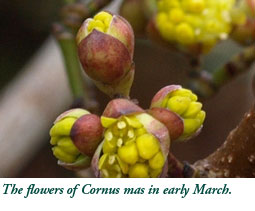
One gardener's favorite color might be like nails on a chalkboard to another. Before I get rid of something that sticks out like a sore thumb, I consider that maybe the problem isn't the color itself, maybe it's how it's used - and challenge myself to figure out how to make it work. Part of the problem in early spring is that there's so little context. A few flowers poking up out of bare earth or a single shrub surrounded by bare sticks does not a garden make. Giving early bloomers thoughtfully chosen companions, rather than dotting them around here and there, is a good way to provide that context. Once we start looking around for other colors, we find there are many ways to avoid personality clashes. The golden branches, delicate chartreuse flowers, and new leaves of weeping willow placed behind forsythia, for example, would speak to its warmth, but create a more harmonious effect; a snazzy vibrant coral flowering quince might be happier paired with a pastel shade of the same hue or something darker that picks up its underlying red tones. A big dose of white - spiraeas, magnolias, cherries - would keep the peace between conflicting hues. Intricate and subtle combinations are great at intimate scale, and are fun to play with. The visual impact of large shrubs and trees calls for large-scale plantings - masses of ground-covering perennials, bulbs, groups of shrubs or trees - to have an effect. Whatever the scale, anything that shows color - not necessarily bloom - at the same time is fair game for the guest list. House color, hardscape elements and even garden furniture and ornaments can make wonderful contributions, but I'm going to focus on plants.
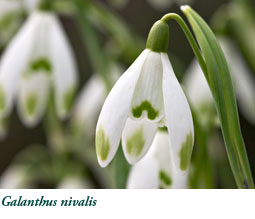
With the wacky weather we've been having, you can't count on many flowers to show up at the right time, or the same time every year. An infestation of voles, or a couple 80-degree days can derail the most carefully considered pairings. But bulbs such as Scilla sibirica, Galanthus nivalis (snowdrops) and a whole slew of daffodils that start out early and keep going for many weeks are a good bet. Hellebores are champs, with subtle flowers in hues of white, chartreuse, buttery yellow, ivory, rosy pink and deep burgundy that last for months and have an attractive presence even as they fade. I'd grow them for the foliage alone, which provides a bold-textured evergreen presence that gets cut back just before they bloom and re-emerges as flowers fade. Early and long-flowering Cornus mas (Cornelian cherries) and Lindera benzoin (spicebush), grown as large shrubs or small trees, create a long-lasting soft haze of small greenish gold blooms that speak to, and moderate, brighter yellows on a larger scale.
I have come to rely on colored foliage, especially golds and silvers, which look good with everything, to keep my deer-infested mountainside garden looking like a garden year-round. Although munching herbivores have discouraged me from planting colored conifers, these obviously present many opportunities for colorful backgrounds and accents that tie together garden scenes. I think of a handful of perennials and woodies with colored foliage that persists into winter, or appears on the scene very early, as my "foul weather friends." They add complexity and nuance, present many opportunities for color echoes, contrasting hues and zippy combinations in the cold months - and keep up the good work as the garden colors up. Those that bloom early add extra spark.
Here are my favorite "other colors," reliable friends that populate my garden come rain, snow, shine, or deer, and keep the conversation lively:
Chartreuse-to-Gold

Helleborus foetidus: Chartreuse bracts display against deep green glossy foliage before flowers open and after they have passed. Great with daffodils, but I can't think of anything they don't look good with. Euphorbias of all kinds, with high-impact yellow-green bracts and tiny yellow flowers that make lively contrasts with their own foliage and surrounding plants.
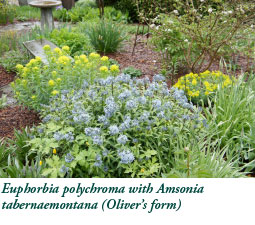
Deutzia 'Chardonnay Pearls': Early emerging gold-green leaves. Spiraea thunbergii 'Ogon': Wands of long-lasting white flowers are soon followed by cheerful green-gold leaves. Acorus gramineus 'Ogon': A grass-like iris relative, striking in golden masses all winter. I enjoy it with the sunny flowers of winter aconites, the earliest daffodils and grape hyacinths, and then cut it back to encourage fresh new clear yellow growth. Yucca 'Golden Sword': like a ray of sunshine all winter. The more I plant the better I like my garden. Lamium maculatum 'Beedham's White': Bright clear yellow foliage emerges early, flowers are white. Sedum 'Angelina': Yellow-chartreuse ground-covering sedum with decidedly orange-russet winter tones. 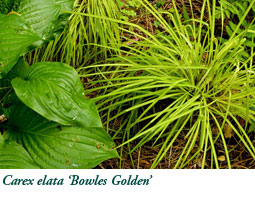
Carex elata 'Bowles Golden': An amiable golden grass with graceful linearity for textural contrast, good until very cold weather or deep snow. New spring foliage emerges blue-green, mixed with and turning to yellow. Silver-Grey-Blue Nepeta x faassenii 'Six Hills Giant': grey-green fuzzy leaves have a presence into December and emerge very early to form a neat mound if old woody stems are cut back. 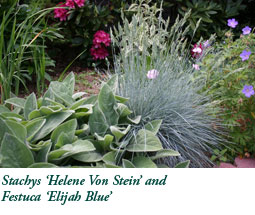
Stachys byzantina: good old lambs ears and it's refined, slightly less silvery cultivar, 'Helene von Stein' are my mainstays. They last long, refresh early in spring and no matter what you put them with, they somehow bring harmony while also being great for contrast. 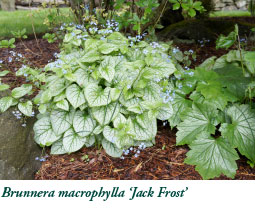
Brunnera macrophylla 'Jack Frost': Who could design a more beautiful leaf? Silver heart-shaped green-ribbed leaves are exquisitely drawn. Emerging early in neat clumps topped by intensely azure forget-me-not-like flowers, leaves enlarge and become more silver as the season progresses. Pulmonarias: I have developed a woodland carpet of silver lungworts with luscious blue, raspberry and pure white flowers under spring-blooming witch hazels, accompanied by various hellebores and early spring bulbs. Starting with silver cultivars, I simply let them self-sow and weed out anything with wimpy flowers or non-silver foliage. Buddleia 'Nanho Blue': This butterfly bush keeps dry silvery leaves in mild winters and refreshes them early in spring. Euphorbia myrsinites: Waxy, intensely blue "donkey tails" have something interesting to say all winter and are stunning with contrasting, intensely acidic chartreuse bracts in spring. Dusky Reds Helleborus x hybridus: Any of the deep dark hellebores add a decidedly sophisticated note, whether accompanied by complex rose-toned hybrids, repeating purple tones of delicate Anemone blanda or in high-key conversation with blue Scilla sibirica. Euphorbia amygdaloides 'Purpurea': Deep dark mysterious foliage containing tones ranging from deep green, almost gray to brilliant claret, topped by a gentle chartreuse at bloom time - a built-in red-green contrast. Penstemon digtalis 'Husker's Red,' 'Dark Towers', Penstemon hirsutis var. pymaeus. Herbaceous penstemons, cut back after bloom, hold their ground with purple-deep red leafy rosettes only enhanced by a coating of frost. It's fun to keep adding color that sustains the conversation over time. On one section of my back slope, dark glossy hellebore foliage and Buxus 'Green Gem' against lichen-covered grey granite boulders are the constants. The hellebore hybrids bloom a deep burgundy red, repeated in the stems of Itea virginica 'Henry's Garnet,' joined by chartreuse Helleborus foetidus (stinking hellebores). By February, a vigorous patch of heirloom snowdrops and bluish-green daffodil foliage accompanies them. As the snowdrops (also sporting bluish-green foliage) fade, graceful white Narcissus 'Thalia' carry on the almost-black and white theme for a very long time. The blue-greens and yellow-greens get along with each other nicely and the dark/light contrast gives it punch. As various yellow, yellow-cupped white and yellow/orange daffodils arrive at the party, they draw a small (and kept that way) forsythia that will later sprout golden variegated leaves into the conversation without allowing it to dominate. The hellebores keep going strong as various gold and chartreuse favorites - Lamium, Carex, Tradescantia 'Sweet Kate', Spiraea 'Gold Mound' - and whites repeat and amplify the theme and make bare ground disappear. White 'Thalia' daffodils spiking through 'Chardonnay Pearls' Deutzia's pale green-gold new leaves on arching branches is particularly pretty. Intensely purple and blue early bulbs - Scilla, Iris reticulata, grape hyacinths and others - drop in on occasion to spice things up and add a cheerful zing against that bright yellow forsythia, followed by spikes of deep purple-blue ajuga (with dark reddish leaves) scampering here and there. This spring, an uninvited guest provided a new challenge: last fall I ordered deep violet hyacinths to accompany the blues, keep company with deep burgundy, vibrate against yellows, and carry on a dark/light contrast. They came up Pepto Bismol pink. I could dig them up, but it's been kind of fun imagining different scenarios that might make that color work within the big scheme. With a color like that in summer, I might really turn up the heat in this predominantly yellow-foliage area by adding a sizzling orange, magenta, and deep dark purple. But such an assertive combination doesn't feel right in a passage that celebrates spring's delicacy. I looked around the garden to see if there were any good companions to transplant into the scene, and held a couple leaves next to the hyacinth to test the idea. 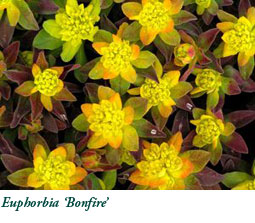
I thought the deep reds of Heuchera 'Frosted Violet', Euphorbia 'Bonfire' or Ajuga 'Caitlin's Giant' might work, but they set up too strong a contrast. Maybe I'll move some closer to the hellebore to give it deep-toned company instead. Complex rosy hellebores seemed out of character with such a simple clear color. Clear blue and pink together seemed too Easter egg-y. So I'm starting my list for the fall bulb order right now, while it's fresh in my mind, and marking the area. I decided that mingling the pink hyacinths with apricot ones would modulate the color (making it more subtle), and transplanting silver lambs ears and chartreuse Helleborus foetidus seems like it will work. And I'll try again for deep violet, maybe snuggled close to the burgundy hellebores. But as I shop, I'll be looking for other candidates. The great luxury of a well-stocked nursery is that you can carry pots around and see how plants will get along before you invite them home. After all, it's your party and you should be able to please yourself in your own garden. Karen Bussolini is a garden photographer, writer, lecturer and eco-friendly garden coach who gardens in South Kent, Connecticut. For information on her slide talks, go to www.greatgardenspeakers.com/listing/karenbussolini.html. © 2012 Karen Bussolini
|
|
|
|
|
|
|

What I Know...
By Andrea Busk
One of the best things about Oliver's is the ability to come into our nursery and really talk about plants and design. We LOVE to talk about plants. We are passionate, opinionated, and occasionally, too long winded. Nonetheless, you can't help but catch our enthusiasm and come away knowing a bit more than before.
As the annuals manager, one of the topics I get enthusiastic about sharing with my customers is how to put together better containers. I often see the drooping faces of customers as they look enviously at our beautifully planted containers and I imagine they think "I can't do that." To them I say, "Yes you can!" Containers are a perfect place for experimentation - feeding that hot tropical urge or that quaint cottage garden look, trying one thing one year and another entirely different look the next. The truth is that there is never one perfect look for a container: there are many, and with a couple of pointers, you are well on your way to designing this year's 'perfect' container.
Size Does Matter
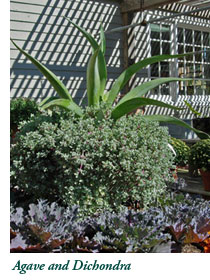 I know they say it doesn't, but it does. It is simply too difficult to get a really great look in a pot that only holds three plants. In my opinion, small pots should be the hosts of a single specimen plant that really says "Wow!" or used in the foreground of a group of containers with plant material that compliments the whole. I know they say it doesn't, but it does. It is simply too difficult to get a really great look in a pot that only holds three plants. In my opinion, small pots should be the hosts of a single specimen plant that really says "Wow!" or used in the foreground of a group of containers with plant material that compliments the whole.
Smaller single specimen pots let you highlight that particular plant's attributes, give the plant room to grow, and make it a cinch to bring in and overwinter. This is an especially good idea with some of our fabulous new Begonias. They look good all on their own, and make excellent house plants - requiring only bright light and a minimum of water all winter. Or try mixing a couple of our interesting succulents in separate pots near a pot of grass, and another pot of bright yellow or orange Portulaca. It's a stunning combination.
With large containers, however, you really can go for incredible visual impact. If it's a large specimen, like a banana plant or a Colocasia (Elephant-ear), it will look voluptuous, especially after it takes some of that generous pot room to grow. You will also have the capacity to under plant these large specimens, adding to the overall effect. If you decide to plant a mixed container in a large pot, that's where some serious fun can be had. Being able to put anywhere between seven to 15 plants in a pot almost ensures that it will be voluptuous and incredible. In fact, it's really hard to make a mistake here if you pick your color way, add some height, some trailers, and then add some foliage or texture to really set the whole thing off. Really - this is supposed to be fun and satisfying, so indulge yourself and don't be afraid to experiment with new and different plants.
Larger containers are also easier to manage throughout the season because they don't require constant care. Their watering and fertilizing needs are less frequent because there is ample room for the roots to get these nutrients, making for fuller, healthier plants and better looking containers.
Hey You, Down in Front
I know we all understand that shade containers should have plants that can tolerate shade, and sun containers should contain sun-loving plants, but your container may have more than one of these environments. Very frequently I am asked to design a container for the front entrance to someone's house. Many of these sites have overhangs, or the container itself may contain plants that act as shade to the plants located in the back of the container. In this case, that sun lover you put in the back of your container will be a leggy, ugly plant, not worthy of the rest of your container. Make sure you understand the sun/shade situation of both the location of your container and the position of the plants you put in the container. There is always a suitable part-sun/shade plant that we can add to your 'sun' container that will complement the design and maintain the fullness and health you want overall.
Flowers, Flowers Everywhere
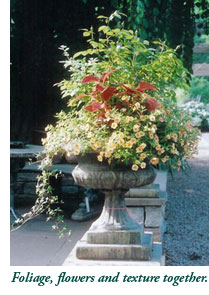 You CAN have too much of a good thing, and having only flowers in your container can end up looking like a big mish-mash. I personally love foliage and texture, and you may have noticed quite a few of our pots at the nursery contain only foliage plants. But, if you are not ready to go cold turkey on the flowers just yet, there really is nothing better than a sweet flower set off by another plant with large, beautiful leaves. Foliage and texture added to your containers will make your flowers look better - no question! So try some. We have incredible foliage plants: multi-colored Coleus leaves, frosty silver trailers like Dichondra, succulents with great architectural structure (one of my current obsessions), and the list just goes on and on. You CAN have too much of a good thing, and having only flowers in your container can end up looking like a big mish-mash. I personally love foliage and texture, and you may have noticed quite a few of our pots at the nursery contain only foliage plants. But, if you are not ready to go cold turkey on the flowers just yet, there really is nothing better than a sweet flower set off by another plant with large, beautiful leaves. Foliage and texture added to your containers will make your flowers look better - no question! So try some. We have incredible foliage plants: multi-colored Coleus leaves, frosty silver trailers like Dichondra, succulents with great architectural structure (one of my current obsessions), and the list just goes on and on.
Do What You Wanna Do
Every year I get customers who come in ready to design their pots, and get asked what plant or plants I like. Well, wait a minute - whose pot is this? What do YOU like? There is no right or wrong answer - just personal choice and some fun. We will always be there to guide you in selecting plants that are appropriate for your container, and will offer you many design suggestions, but in the end this container should make you happy. Have fun, try some crazy plant that attracts you, experiment like crazy, because that is what makes containers different from your garden beds - you can change them every year. Containers are a great place to experiment and discover your inner design preferences. No one gets good at this without a couple of failures (we have had more than our share, too) and plants don't always perform like we want them to, but that is the way we learn to do things better.
So come on. Give it a try. Have fun. And let's see what your 'perfect' container looks like this year!
|
|
The Little Willows
By Lori Chips
By virtue of their habit, leaf, and structure, the small willows seem to have distilled the very essence of the picturesque. Sometimes, even without knowing it, this is exactly what the rock gardener has been searching for: the windswept anchoring shrub to grace a trough or wall. A nice divergence from the parade (of admittedly adorable) dwarf conifers, the smaller Salixes can be used as a woody element, although not an evergreen one. This is not to say that the leafless winter aspect of this clan is dull. Far from it! You'll find the off-season trunk and branches intricate in their own right, and loaded with personality.
 To begin at the end of the alphabet, let's first consider a plant that has been a feature in our gardens for many years. One of the best for winter branch and trunk beauty is Salix nakamurana v. yezoalpina from Hokkaido, Japan. This one is only dwarf in respect to its height (6"- 10" tall), since it can spread sideways several yards, eating up substantial lateral real estate. One of the most captivating attributes of this low prostrate shrub is the way that it "flows" downhill. It forms roots easily, and will course over a sizable boulder taking advantage of any cracks to root in as it goes. So why would a lover of the tiny, the difficult-to-keep, the precious, and the minute be interested in a plant that is easy, and is, admittedly a space-hog? Well personally, I respond to its leafless look. The branches are often substantial and are gnarled and twisted: the bronzy bark attractive in its own right. It can be planted in a difficult spot, not being terribly fussy about location. It will take some abuse and it will, in fact, welcome all sorts of pruning. We have one specimen that is called upon to provide cuttings for our crop, season after season. Besides that it gets rudely shorn to keep it out of the gravel pathway. In fact, this treatment seems only to increase the thickness and muscularity of the trunk and branches, adding to its sculptural appeal. This is one plant that lends itself to being designed with; try it tumbling down a slope or a rock wall. It looks beautiful all year when planted solo in a trough. You may be wondering, "How can such a vigorous shrub learn to be content in a trough?" There are two things to know about this: the deeper the pot the better, and even so, the willow will probably root through the bottom and into the ground. To prevent this (even on a flagged patio) it should be moved several times a season. Simply spin it in place to keep it from delving down. The other thing to know is that, given its root bound condition over time, and regardless of regular feeding and watering, containerized S. yezoalpinas will generally drop their leaves in fall sooner than their in-ground brothers. To begin at the end of the alphabet, let's first consider a plant that has been a feature in our gardens for many years. One of the best for winter branch and trunk beauty is Salix nakamurana v. yezoalpina from Hokkaido, Japan. This one is only dwarf in respect to its height (6"- 10" tall), since it can spread sideways several yards, eating up substantial lateral real estate. One of the most captivating attributes of this low prostrate shrub is the way that it "flows" downhill. It forms roots easily, and will course over a sizable boulder taking advantage of any cracks to root in as it goes. So why would a lover of the tiny, the difficult-to-keep, the precious, and the minute be interested in a plant that is easy, and is, admittedly a space-hog? Well personally, I respond to its leafless look. The branches are often substantial and are gnarled and twisted: the bronzy bark attractive in its own right. It can be planted in a difficult spot, not being terribly fussy about location. It will take some abuse and it will, in fact, welcome all sorts of pruning. We have one specimen that is called upon to provide cuttings for our crop, season after season. Besides that it gets rudely shorn to keep it out of the gravel pathway. In fact, this treatment seems only to increase the thickness and muscularity of the trunk and branches, adding to its sculptural appeal. This is one plant that lends itself to being designed with; try it tumbling down a slope or a rock wall. It looks beautiful all year when planted solo in a trough. You may be wondering, "How can such a vigorous shrub learn to be content in a trough?" There are two things to know about this: the deeper the pot the better, and even so, the willow will probably root through the bottom and into the ground. To prevent this (even on a flagged patio) it should be moved several times a season. Simply spin it in place to keep it from delving down. The other thing to know is that, given its root bound condition over time, and regardless of regular feeding and watering, containerized S. yezoalpinas will generally drop their leaves in fall sooner than their in-ground brothers.
I have as yet failed to mention this plant's shining Kodak moment. In spring as the vegetative buds unfurl their new leaves, the sage green is lightened and frosted by abundant silver fur. Tantalizing to the touch, naturally, but if there happens to be a drop or two of rain or dew suspended there, few gardeners will be able to resist reaching for a camera.
The next willow just may be the perfect non-coniferous trough shrub. Salix arctica 'Petrea' will, with very little tampering, achieve a "Bonsai" look in a very few years. Sometimes, in the first couple of years, the push of new branching growth can seem a little bit daunting. I like to approach it as a sculpture-in-progress. One way to handle it is to encourage a leader or two to head skyward, and remove some lower branches. This will give you a trunk with a bit of height. Don't worry! Even the leaders will succumb to their innate nature and begin to weep downwards. This allows you to build the lift before the fall. It helps, on roughly a yearly basis to "hollow out" a kind of cavern surrounding the trunk; prune to decongest that area. Step back frequently; leave a window to peek inside the cave, too. The magic moment for Salix arctica 'Petraea' happens a short time after the spring leaves emerge. Given that your pruning has helped achieve a windswept arc to the plant, the spattering of light green oval leaves complete the Japanese painterly look.
Off the Irish coast is an island group known as the Outer Hebrides. Saint Kilda is the western-most island. It is the home of Salix repens Saint Kilda's Form. If you are familiar with alpine habitats, you may have heard that there are places at sea level whose harsh conditions replicate the growing conditions found above timberline. This is one such place. If you are looking for a sweet diminutive willow for a trough, you have found one. Easy to grow, and bearing abundant catkins in spring, this form of repens will become a mat, and flow over the side of a wall or container. Saint Kilda's Form is best used as a cascader or ground cover as it tends to remain low.
Brand new for us this year: Salix lindleyana is a tiny creeper that eventually forms a mat or carpet. The diminutive stems are ground hugging and slow growing. The plant is crowned in spring with a plethora of red catkins that will often deepen to black. It must have a cool, moist, gritty soil, but will take full sun. Reaching only three inches in height, by, eventually, eighteen inches wide, this enchanting Salix comes from the mountains of Nepal.
Next we come to Salix helvetica. A bit large for most troughs, the Swiss Willow offers us enchanting, season-long silver in its felted lancelet leaves. The golden buds contrast strikingly with the foliage. Unlike most of the other small willows, this one does not eat up space horizontally, but instead produces a head of silver leaves on many branches. It is slow growing. Give it ample sun, but not too dry of a spot. And try contrasting it with black or burgundy leaves, or even deep toned stone and gravel.
The first time I caught sight of Salix xboydii I knew I had to own it. Its habit is small, congested, and Bonsai-like without ever having a blade taken to it. The trunk and branches are gnarled, and the round leaves are covered in felt in the spring. Later in the season, the tops of the leaves become leathery. The color of the felt is a dark, stormy gunmetal grey - very distinctive. The stems of this plant are golden in winter. Only the female form is known; it was discovered as a single seedling by a Dr. William Boyd in Scotland during the time of the Victorians, near Glen Clova. It is thought that Salix lanata and Salix reticulata were involved in the parentage. Salix xboydii is one of the choicest of willows, and will be available in extremely limited numbers. It possesses a look of ancient venerability even as a pretty young plant.
Although not a wildly flamboyant group, the little willows offer us a lot of charm. Include them in your repertory. Then sit back and watch how the silver of a leaf, the delicacy of branch work, and the sinewy strength of a trunk bestow a measure of character in every season.
Illustration by Lori Chips
© 2012 Lori Chips
|

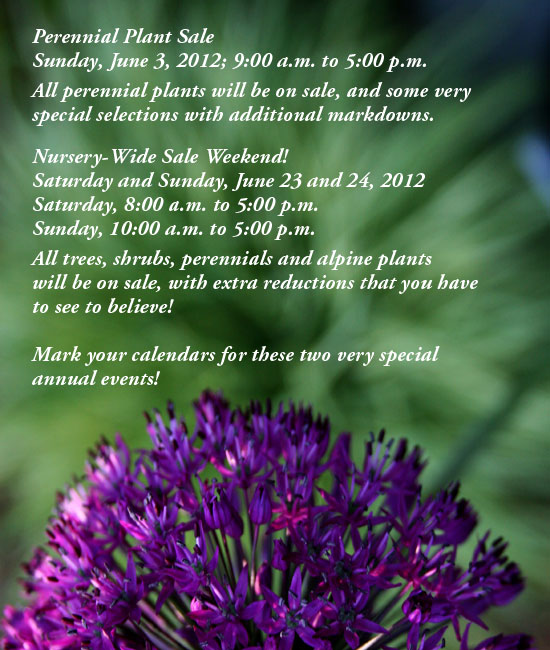
|
 
|

Trough Inspirations
Although our designated trough-making season is still some months off, we thought it might be fun and informative to ask you miniature plant fans for input on our production. Each year, we generate a "goal list" of shapes, some created in our standard molds, and some on one-of-a-kind sand molds where our imagination (and gravity!) are our only real limitations. We have an aesthetic standard to which we adhere and we keep a practical eye on things like tolerances, widths and usability. This simply means that:
1. We do not produce "Lucky Charms" (no clover leafs, hearts, donuts or daisies).
2. The construction of the piece must be strong and plant-friendly.
In the past, we have produced a few custom-made troughs to the design and dimensions of the client. We have also, on occasion, been asked to fill a "wish list" for a certain number of shapes, such as small cylinders, to be ready for spring.
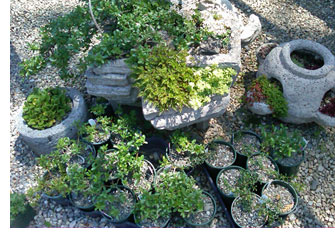 So we would like to invite you, our trough gardening public, to weigh in with your ideas. Is there a shape we have not thought of? Are you looking for troughs of a certain size? We are open to producing a custom trough if you have an inspiration. Let us know! We will definitely need to have a conversation about the idea you have, and the logistics of making it. We will also need a down payment if we decide to go ahead. You may have a corner that will be perfectly completed by a certain-sized triangle, a spot that needs a tall tower, or a setting on a wall that cries out for a long narrow "window box." Trough-making gets underway at the end of October, and we are finished with production just before Christmas. We would love to hear your thoughts! So we would like to invite you, our trough gardening public, to weigh in with your ideas. Is there a shape we have not thought of? Are you looking for troughs of a certain size? We are open to producing a custom trough if you have an inspiration. Let us know! We will definitely need to have a conversation about the idea you have, and the logistics of making it. We will also need a down payment if we decide to go ahead. You may have a corner that will be perfectly completed by a certain-sized triangle, a spot that needs a tall tower, or a setting on a wall that cries out for a long narrow "window box." Trough-making gets underway at the end of October, and we are finished with production just before Christmas. We would love to hear your thoughts!
Contact us at: (203) 259-5609, or lori.chips@olivernurseries.com
|

 For more information visit our Web site at www.olivernurseries.com, or call us at 203-259-5609. For more information visit our Web site at www.olivernurseries.com, or call us at 203-259-5609.
Image in header: Detail from Spring, engraving by Bruegel. The Metropolitan Museum of Art. Dick Fund, 1926.
Oliver's gardens photographed by Mimi Dekker. Copyright 2011 Oliver Nurseries |
|
|
|
|
|
|
|